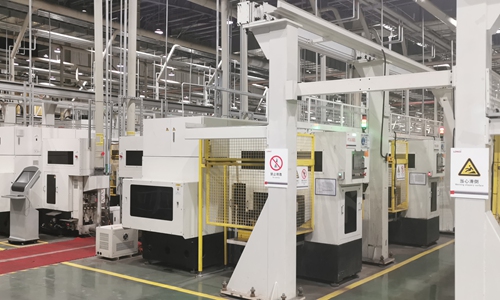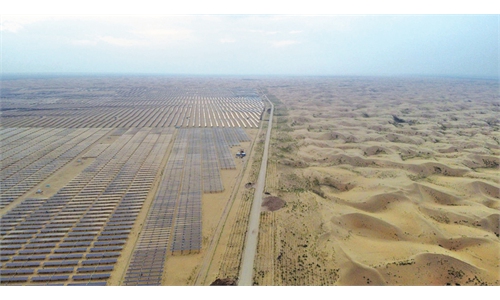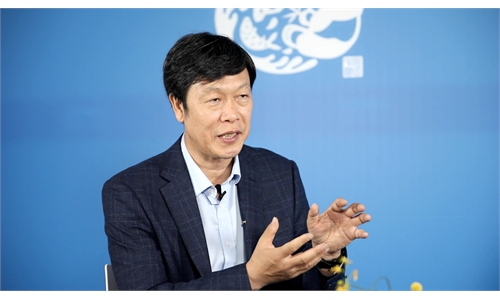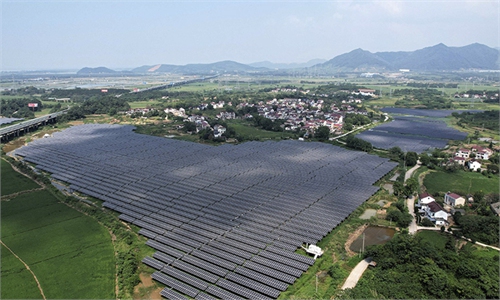China’s photovoltaic industry undisrupted by US’ move to build industrial cluster in India
Domestic players expand into Southeast Asia

A wafer production workshop of Qujing Longi Silicon Materials Co in Qujing, the PV industrial hub in Southwest China's Yunnan Province. Photo: Yin Yeping/GT
China's leading photovoltaic (PV) industry conglomerates won't be disrupted by the US' recent attempt to build a PV industrial cluster in India, a move intended to replace China's leading position in the region, industry insiders said.
Foreign media reports said that a US foreign-development agency intends to lend $500 million to build a solar-panel factory in India in a bid to weaken China's dominance in the solar industry's supply chain.
While this step by the US is an indication of a new squeeze against China's PV industry and its global influence, industry leaders told the Global Times on Tuesday that with China's government policy support, rising market demand, highly independent production line and advanced cost controls, China's leading status in the PV supply chain will remain strong.
Domestic industry leaders and the local government are turning Qujing, a city in Southwest China's Yunnan Province, into a world PV industry cluster, driven by booming demand in Southeast Asian countries, where solar energy plays an increasingly important part in regional economic development, despite the US attempt to replace China's leading position in the regional supply chain.
Lei Zhigang, director of the general manager's office at Qujing Longi Silicon Materials Co, a subsidiary of the world-leading solar technology corporation, is not worried that the recent US plan in India.
Longi dropped a plan for the acquisition of a US PV company after noticing its cost control target, to be achieved three years from now, has already been reached by Longi at half the price, Lei said, indicating why the company is not worried about US posturing in the field.
As for India, its technology and equipment cannot be compared with China, Lei said.
Longi invested in India before, but the investment was suspended due to the tensions between China and India, sad Lei, while demand in the Indian market has kept growing.
Southeast Asia is an emerging market for PV power generation. In 2019, its cumulative photovoltaic installed capacity was only 12.6 gigawatts, but the number is growing rapidly, with greater market potential ahead.
What Longi is producing in Qujing, Yunnan is mainly silicon wafers, which are sliced into components, before being shipped to downstream factories in Southeast Asia to make photovoltaic cells for the world market.
Longi has two major downstream plants in Southeast Asia -- one in Malaysia and another in Vietnam - and both are at full operation.
"Exports are an important part and are expected to be augmented in the future," Lei said.
A person with JA Solar, another manufacturer of high-performance PV products, with a factory based in Qujing, told the Global Times on Tuesday that she does not see the possibility of the supply chain being taken over by others, given the company's advanced global layout.
JA Solar has more than 20 specialized marketing companies overseas, including in the US, and its PV products are sold to 135 countries and regions. But the place where it has the biggest market potential is China. In photovoltaic installations, China accounted for 35.8 percent of the world.
The core production capacity of the entire PV industry chain is almost all in China, with silicon wafers, for example, accounting for 97 percent of global output and silicon materials for about 75 percent.
Qujing's increasingly important role as a transport hub of the Belt and Road Initiative, especially after the opening of the China-Laos Railway earlier, is expected to draw more new energy-related companies to the region, which they may use as a convenient steppingstone for expansion to all of Southeast Asia, industry insiders said.
Zhang Bing, general manager of Yunnan Energy Investment Silicon Technology Development Co, told the Global Times that, with the opening of the China-Laos railway, the entire logistics system has become increasingly mature, giving companies an advantage in reaching out to Southeast Asian countries with reasonable prices.
Zhang's company is negotiating cooperation with local companies in Vietnam and it plans to supply them with organic silicon raw materials for products that include green-energy generation.
The company exports about 10-20 of its products, mainly to Europe and the Americas, and demand remains strong.



